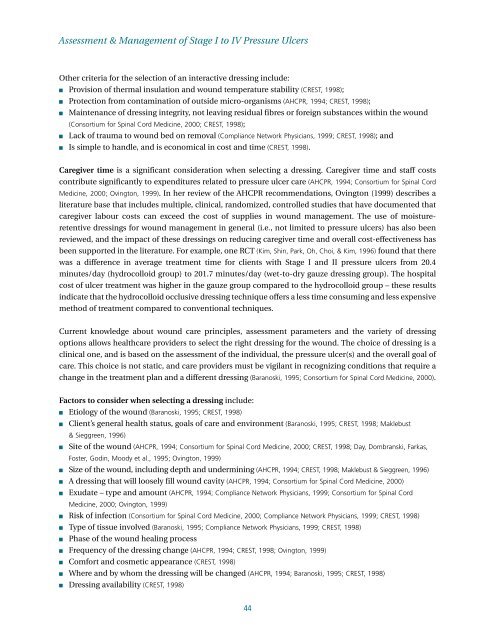RNAO BPG Pressure Ulcers Stage I to IV - Faculty of Health ...
RNAO BPG Pressure Ulcers Stage I to IV - Faculty of Health ...
RNAO BPG Pressure Ulcers Stage I to IV - Faculty of Health ...
You also want an ePaper? Increase the reach of your titles
YUMPU automatically turns print PDFs into web optimized ePapers that Google loves.
Assessment & Management <strong>of</strong> <strong>Stage</strong> I <strong>to</strong> <strong>IV</strong> <strong>Pressure</strong> <strong>Ulcers</strong>Other criteria for the selection <strong>of</strong> an interactive dressing include:■ Provision <strong>of</strong> thermal insulation and wound temperature stability (CREST, 1998);■ Protection from contamination <strong>of</strong> outside micro-organisms (AHCPR, 1994; CREST, 1998);■■Maintenance <strong>of</strong> dressing integrity, not leaving residual fibres or foreign substances within the wound(Consortium for Spinal Cord Medicine, 2000; CREST, 1998);Lack <strong>of</strong> trauma <strong>to</strong> wound bed on removal (Compliance Network Physicians, 1999; CREST, 1998); and■ Is simple <strong>to</strong> handle, and is economical in cost and time (CREST, 1998).Caregiver time is a significant consideration when selecting a dressing. Caregiver time and staff costscontribute significantly <strong>to</strong> expenditures related <strong>to</strong> pressure ulcer care (AHCPR, 1994; Consortium for Spinal CordMedicine, 2000; Oving<strong>to</strong>n, 1999). In her review <strong>of</strong> the AHCPR recommendations, Oving<strong>to</strong>n (1999) describes aliterature base that includes multiple, clinical, randomized, controlled studies that have documented thatcaregiver labour costs can exceed the cost <strong>of</strong> supplies in wound management. The use <strong>of</strong> moistureretentivedressings for wound management in general (i.e., not limited <strong>to</strong> pressure ulcers) has also beenreviewed, and the impact <strong>of</strong> these dressings on reducing caregiver time and overall cost-effectiveness hasbeen supported in the literature. For example, one RCT (Kim, Shin, Park, Oh, Choi, & Kim, 1996) found that therewas a difference in average treatment time for clients with <strong>Stage</strong> I and II pressure ulcers from 20.4minutes/day (hydrocolloid group) <strong>to</strong> 201.7 minutes/day (wet-<strong>to</strong>-dry gauze dressing group). The hospitalcost <strong>of</strong> ulcer treatment was higher in the gauze group compared <strong>to</strong> the hydrocolloid group – these resultsindicate that the hydrocolloid occlusive dressing technique <strong>of</strong>fers a less time consuming and less expensivemethod <strong>of</strong> treatment compared <strong>to</strong> conventional techniques.Current knowledge about wound care principles, assessment parameters and the variety <strong>of</strong> dressingoptions allows healthcare providers <strong>to</strong> select the right dressing for the wound. The choice <strong>of</strong> dressing is aclinical one, and is based on the assessment <strong>of</strong> the individual, the pressure ulcer(s) and the overall goal <strong>of</strong>care. This choice is not static, and care providers must be vigilant in recognizing conditions that require achange in the treatment plan and a different dressing (Baranoski, 1995; Consortium for Spinal Cord Medicine, 2000).Fac<strong>to</strong>rs <strong>to</strong> consider when selecting a dressing include:■ Etiology <strong>of</strong> the wound (Baranoski, 1995; CREST, 1998)■ Client’s general health status, goals <strong>of</strong> care and environment (Baranoski, 1995; CREST, 1998; Maklebust& Sieggreen, 1996)■ Site <strong>of</strong> the wound (AHCPR, 1994; Consortium for Spinal Cord Medicine, 2000; CREST, 1998; Day, Dombranski, Farkas,Foster, Godin, Moody et al., 1995; Oving<strong>to</strong>n, 1999)■ Size <strong>of</strong> the wound, including depth and undermining (AHCPR, 1994; CREST, 1998; Maklebust & Sieggreen, 1996)■ A dressing that will loosely fill wound cavity (AHCPR, 1994; Consortium for Spinal Cord Medicine, 2000)■ Exudate – type and amount (AHCPR, 1994; Compliance Network Physicians, 1999; Consortium for Spinal CordMedicine, 2000; Oving<strong>to</strong>n, 1999)■ Risk <strong>of</strong> infection (Consortium for Spinal Cord Medicine, 2000; Compliance Network Physicians, 1999; CREST, 1998)■ Type <strong>of</strong> tissue involved (Baranoski, 1995; Compliance Network Physicians, 1999; CREST, 1998)■ Phase <strong>of</strong> the wound healing process (Compliance Network Physicians, 1999; CREST, 1998)■ Frequency <strong>of</strong> the dressing change (AHCPR, 1994; CREST, 1998; Oving<strong>to</strong>n, 1999)■ Comfort and cosmetic appearance (CREST, 1998)■ Where and by whom the dressing will be changed (AHCPR, 1994; Baranoski, 1995; CREST, 1998)■ Dressing availability (CREST, 1998)44
















